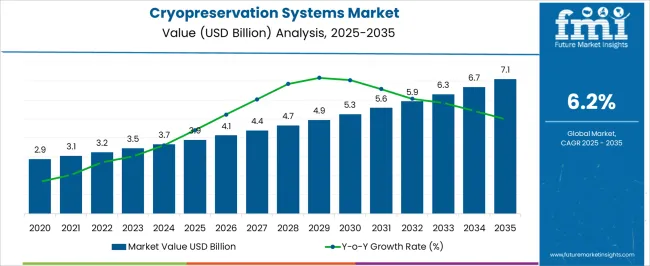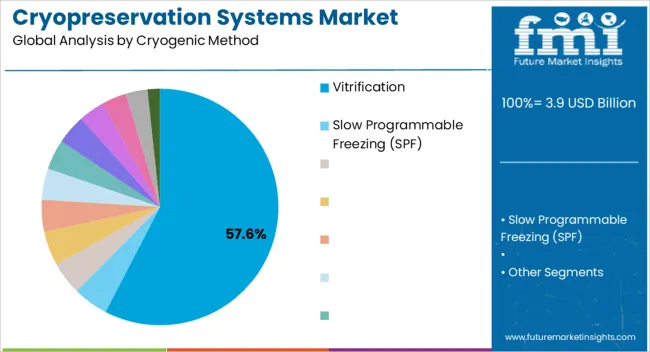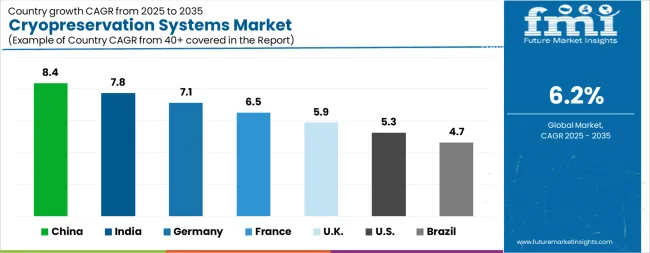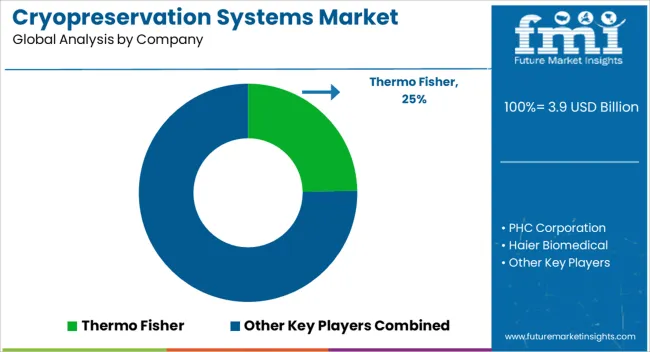The Cryopreservation Systems Market is estimated to be valued at USD 3.9 billion in 2025 and is projected to reach USD 7.1 billion by 2035, registering a compound annual growth rate (CAGR) of 6.2% over the forecast period.

| Metric | Value |
|---|---|
| Cryopreservation Systems Market Estimated Value in (2025 E) | USD 3.9 billion |
| Cryopreservation Systems Market Forecast Value in (2035 F) | USD 7.1 billion |
| Forecast CAGR (2025 to 2035) | 6.2% |
The Cryopreservation Systems market is experiencing steady growth driven by the increasing demand for long-term preservation of biological materials in research, clinical, and assisted reproductive applications. The market is being shaped by advancements in cryogenic technologies that enhance cell viability and reduce damage during storage and thawing. Investments in biobanking infrastructure, regenerative medicine, stem cell research, and fertility clinics are contributing to widespread adoption of advanced cryopreservation solutions.
Increasing awareness of the benefits of cryopreservation for genetic material, embryos, gametes, and tissue samples is further supporting market expansion. The market is also benefiting from improvements in system automation, safety protocols, and monitoring technologies that ensure high reliability and reproducibility.
As research institutions and healthcare facilities continue to prioritize the storage of biological samples for clinical, therapeutic, and research purposes, the demand for efficient and scalable cryopreservation systems is expected to remain strong Future growth opportunities are anticipated in the development of hybrid systems that integrate software-controlled storage management with advanced cooling techniques, enabling enhanced flexibility and operational efficiency.
The cryopreservation systems market is segmented by cryogenic method, and geographic regions. By cryogenic method, cryopreservation systems market is divided into Vitrification and Slow Programmable Freezing (SPF). Regionally, the cryopreservation systems industry is classified into North America, Latin America, Western Europe, Eastern Europe, Balkan & Baltic Countries, Russia & Belarus, Central Asia, East Asia, South Asia & Pacific, and the Middle East & Africa.

The vitrification method is projected to hold 57.60% of the Cryopreservation Systems market revenue share in 2025, making it the leading cryogenic method. This dominance is being attributed to its ability to prevent ice crystal formation during freezing, thereby preserving cellular integrity and viability more effectively than conventional slow-freezing techniques. The growth of this segment has been accelerated by widespread adoption in fertility clinics, stem cell storage, and tissue preservation, where high survival rates after thawing are critical.
Vitrification offers rapid cooling and warming, which reduces thermal stress and minimizes structural damage to delicate biological materials. Its advantages in maintaining the functional and genetic integrity of embryos, oocytes, and other cell types have contributed to the preference for this method in clinical and research applications.
The segment’s leading position is further supported by the increasing need for reproducible results, standardized protocols, and high-throughput storage solutions in biobanking and assisted reproductive technologies As demand for improved cryopreservation outcomes continues to rise, the vitrification method is expected to maintain its dominant position in the market.
Cryogenic conservation systems, commonly referred to as cryogenic preservation or cryopreservation systems, are storage systems in which cells, organelles, extra-cellular matrix, organs, tissues or other biological components and parts, which are susceptible to unregulated atmospheric and chemical kinesis damage, can be preserved at extremely low temperatures. Cryopreservation systems typically store biological components at minus 80 degree Celsius using carbon dioxide.
However, the utilization of liquid nitrogen enables cryopreservation systems to drop the temperature to approximately 196 degree Celsius. Cryopreservation systems incorporate such low temperatures to cease and desist all chemical and enzymatic activities that might cause permanent damage to the biological specimen. These systems reach such extremely low temperatures and yet, eliminate the formation of ice.
Traditional cryopreservation systems used a coating of biological material with a class of molecules called cryo-protectants that froze the biological material in question and minimized the damage caused by unregulated atmospheric chemical kinetics. Modern systems are continuously being researched and upgraded to eliminate the underlying toxicity of various cryo-protectants.
By default, the process incorporated by these systems compromises the structural and functional behavior of biological cells, unless proven otherwise for a specific class of cell population.

| Country | CAGR |
|---|---|
| China | 8.4% |
| India | 7.8% |
| Germany | 7.1% |
| France | 6.5% |
| UK | 5.9% |
| USA | 5.3% |
| Brazil | 4.7% |
The Cryopreservation Systems Market is expected to register a CAGR of 6.2% during the forecast period, exhibiting varied country level momentum. China leads with the highest CAGR of 8.4%, followed by India at 7.8%. Developed markets such as Germany, France, and the UK continue to expand steadily, while the USA is likely to grow at consistent rates. Brazil posts the lowest CAGR at 4.7%, yet still underscores a broadly positive trajectory for the global Cryopreservation Systems Market. In 2024, Germany held a dominant revenue in the Western Europe market and is expected to grow with a CAGR of 7.1%. The USA Cryopreservation Systems Market is estimated to be valued at USD 1.4 billion in 2025 and is anticipated to reach a valuation of USD 2.3 billion by 2035. Sales are projected to rise at a CAGR of 5.3% over the forecast period between 2025 and 2035. While Japan and South Korea markets are estimated to be valued at USD 198.5 million and USD 131.8 million respectively in 2025.

| Item | Value |
|---|---|
| Quantitative Units | USD 3.9 Billion |
| Cryogenic Method | Vitrification and Slow Programmable Freezing (SPF) |
| Regions Covered | North America, Europe, Asia-Pacific, Latin America, Middle East & Africa |
| Country Covered | United States, Canada, Germany, France, United Kingdom, China, Japan, India, Brazil, South Africa |
| Key Companies Profiled | Thermo Fisher, PHC Corporation, Haier Biomedical, B Medical Systems, Vestfrost Solutions, Helmer Scientific, KIRSCH, Eppendorf, Arctiko, Follett, and Nihon Freezer |
The global cryopreservation systems market is estimated to be valued at USD 3.9 billion in 2025.
The market size for the cryopreservation systems market is projected to reach USD 7.1 billion by 2035.
The cryopreservation systems market is expected to grow at a 6.2% CAGR between 2025 and 2035.
The key product types in cryopreservation systems market are vitrification and slow programmable freezing (spf).
In terms of , segment to command 0.0% share in the cryopreservation systems market in 2025.






Full Research Suite comprises of:
Market outlook & trends analysis
Interviews & case studies
Strategic recommendations
Vendor profiles & capabilities analysis
5-year forecasts
8 regions and 60+ country-level data splits
Market segment data splits
12 months of continuous data updates
DELIVERED AS:
PDF EXCEL ONLINE
Cryopreservation Freezers Market Outlook – Size & Forecast 2025-2035
Cryopreservation for In-vitro Fertilization (IVF) Market - Trends & Forecast 2025 to 2035
Cryopreservation Cell Lines Market
Systems Administration Management Tools Market Size and Share Forecast Outlook 2025 to 2035
VRF Systems Market Growth - Trends & Forecast 2025 to 2035
Cloud Systems Management Software Market Size and Share Forecast Outlook 2025 to 2035
Hi-Fi Systems Market Size and Share Forecast Outlook 2025 to 2035
Cough systems Market
Backpack Systems Market Size and Share Forecast Outlook 2025 to 2035
Unmanned Systems Market Analysis - Size, Share, & Forecast Outlook 2025 to 2035
DC Power Systems Market Trends - Growth, Demand & Forecast 2025 to 2035
Catheter Systems Market
Reporter Systems Market
Aerostat Systems Market
Cryogenic Systems Market Size and Share Forecast Outlook 2025 to 2035
Air Brake Systems Market Growth & Demand 2025 to 2035
Metrology Systems Market
Fluid Bed Systems Market
Cognitive Systems Spending Market Report – Growth & Forecast 2016-2026
Nurse Call Systems Market Insights - Size, Share & Forecast 2025 to 2035

Thank you!
You will receive an email from our Business Development Manager. Please be sure to check your SPAM/JUNK folder too.
Chat With
MaRIA